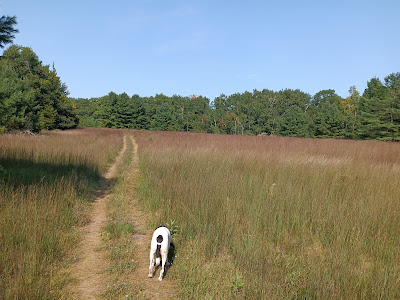The Algonquin hike was done on August 26, 2021, and on June 21, 2022, I hiked the Chippewa Trail. From the parking area to the tip of the peninsula is 2.5 miles. Going back to the Twin Pine Campsite's intersection, then going West on the Algonquin, and looping around to the parking area is a 5.6-mile hike.
The trail takes you through some dense forest.
This is the first of four campsites. I hope to camp here the night of June 21, 2022.
The campsites have a picnic table, firepit, bear-proof trash can, and pit toilet. All give you a fabulous view of Lake Huron. I'm going to be falling asleep to the sound of waves.
I could not hike the Chippewa Trail due to a Bald Eagles nest. I hope to be able to walk it the next time.
This portion would be the grassland.
The end of the trail came to this narrow rocky peninsula.
Took a selfie of Gypsy and me at the very tip of the peninsula.
This is what was behind our selfie picture.
The Algonquin Trail was a bit less traveled on the loopback.
The Chippewa Trail still had the eagle's nest, but the DNR officer said it was more of a suggestion not to hike the trail. It was a challenging hike with fallen trees and lots of water and muck to walk through.
Basically, you walked through a little clearing through the woods. I love trails like this!
I had to walk through swamp water many times on the Chippewa Trail.
Because of the eagle's nest, which I did not see, the DNR is not maintaining the Chippewa Trail even though I was looking for it. There were numerous times I had to climb over and under to go around fallen trees.
You will recognize the names (Algonquin, Potawatomi, and Chippewa) as Michigan Indian tribes if you're from Michigan. The park is named after Chief Negwegon of the Ojibwa tribe who lived in the area.




.jpg)









No comments:
Post a Comment